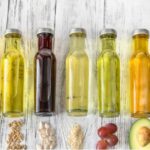What Is Silicone Made of?
Silicone is one of the most commonly used synthetic materials today. This versatile material found its way into kitchen supplies in the early 2000s and today many cookware items and kitchen accessories are made of silicone. Silicone kitchen utensils impress with their bright colors, non-stick surface, and chemical inertness.
There are a variety of silicone baking pans available, but like any other material, silicone has both advantages and disadvantages.
Pros of Silicone Bakeware
- Non-stick property. The big selling point of silicone baking pans is that food doesn’t stick to them and whatever you bake turns out hassle-free. Cakes and muffins keep their shape. You don’t need to cover the pan with oil and cleaning is a breeze.
- A wide variety of colors. Silicone kitchenware is offered in a range of bold, bright colors. The fun colors attract everyone’s attention and can be interesting for children who enjoy their meals in colorful dishes. A variety of colors also help you organize items for different types of food and prevent cross-contamination.
- Chemical inertness. Silicone is a chemically inert material that can be microwaved without fear of leaching chemicals into food. You can also use silicone bowls to melt butter or other warm ingredients. Silicone baking pans do not lose their color or absorb stains and odors, no matter what type of food you bake in them.
- Ease of cleaning. Silicone bakeware can be cleaned in the dishwasher, but can also be easily cleaned by hand. Baked goods do not stick to silicone, so no scrubbing is required. The flexible nature of silicone allows for easy removal of baked goods. It is not necessary to put the pan in the dishwasher after each use. You can wash it with a sponge soaked in soapy water. Over time, a film of grease can build up on silicone baking pans from cooking sprays and food. This greasy film usually disappears after machine washing. If you still feel any traces of grease, soak the silicone bakeware in hot water with grease-dissolving detergent. Let it sit for half an hour and then scrub with a non-abrasive sponge. If stubborn stains remain, apply baking soda paste and let it sit for an hour.
- Durability. Silicone bakeware can be bent without losing its shape. It won’t be ruined if you drop it. It won’t shatter in the oven or freezer like glass. The colors do not fade quickly and it looks like new after repeated use and washing. Some scratches may be caused by sharp knives or other metal utensils. You can continue to use such baking pans, but you must clean them thoroughly after each use to prevent bacteria from growing in the cracks.
- You don’t burn your fingers. A second selling point is that you can touch a silicone pan shortly after removing it from the oven without burning yourself. This low thermal conductivity makes silicone ideal for making handle sleeves for pots and pans.
This post contains links to Amazon. The publisher may get paid if You purchase something through the links without additional costs to You.
Related product: Silicone Loaf Pan – Non-Stick Oven Dish
Cons
- A chemical smell after the first few uses. Silicone baking pans can give off a strong chemical smell when unpacked. This smell can transfer to the food you bake. Usually, it disappears after use and thorough cleaning.
- Low thermal conductivity. Silicone bakeware transfers heat more slowly than metal bakeware, so the baking process may take a few minutes longer than usual. Once done, your cake will not be brown and crispy around the edges.
- Hard to handle when full. Because a silicone pan is not rigid like metal, it is difficult to maneuver the pan full of food. You must be particularly careful when transporting it to the oven. Use a baking sheet or metal tray underneath to avoid messy mishaps. Some baking pans come with steel rims to give them stability and make it much easier to transport them to the oven. The positive side of flexibility is that it allows quick release of baked goods from the pan.
- Not environmentally-friendly. Silicone products are more environmentally friendly than plastic products because they reduce the use of single-use plastic products. However, we cannot consider silicon as an environmentally friendly material. Silicone is not biodegradable and can take up to 500 years to break down. Silicon can be recycled, but recycling centers are rare. Another problem is that the recycling process requires toxic chemicals that harm the environment.
Can Silicone Go in The Oven?
In general, silicone bakeware is oven-safe up to 428℉ (220℃). Some pieces can even withstand higher temperatures. Always check the manufacturer’s specifications to find out the recommended oven temperature for a particular bakeware.
Can Silicone Bakeware Go in The Microwave?
Silicone cookware can be used in the microwave. However, you should read the instructions before putting it in the microwave. Silicone can heat up when placed in the microwave. Therefore, gloves are required to protect your hands.
Can Silicon Go in The Freezer?
Silicone bowls are cold-resistant and can be safely used to freeze food prepared in them. FDA-approved food-grade silicone can withstand temperatures of -80°F (-60 degrees Celsius).
Can You Put Silicone Bakeware in The Dishwasher?
Silicone bakeware is easy to care for and can be easily cleaned in the dishwasher. Since the food does not stick, washing it by hand is also possible without any problems. Warm soapy water and sponge are all you will need for cleaning after each use.
Is Silicone Safe for Baking?
The safety of silicone for food contact is often debated. This is especially true for baking pans. When heated above 260 degrees, silicone is no longer stable and can release compounds called siloxanes, which are toxic to some degree. Some experts recommend not using silicone at temperatures above 260 degrees.
The FDA has defined standards that must be met to use silicone that comes into contact with food. Food-grade silicone should not contain any substances harmful to health.
When purchasing silicone baking pans, always make sure that the piece you are interested in is made of food-grade silicone. Cheaply made items may contain fillers that are not suitable for baking foods. The presence of fillers can make silicone less resistant to temperature and affect the taste of the food.



